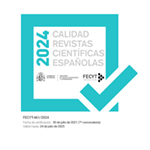Imágenes de revelación: iluminaciones del universo en el Liber Divinorum Operum de Hildegard Von Bingen
Resumen
El objetivo de esta investigación es profundizar en la vida y pensamiento de la religiosa Hildegard von Bingen (1098-1179) a través del análisis de las iluminaciones del universo con forma de ser humano de una de sus obras más destacadas, Liber Divinorum Operum (El libro de las horas divinas). En plena Edad Media y desde los espacios de clausura, Hildegard von Bingen desarrolló una abundante producción teórica creativa en áreas muy diversas, encabezó algunas de las reformas más importantes de su momento, tuvo relación con personajes relevantes de su época y adquirió el poder que a las mujeres les estaba vedado. Las imágenes estudiadas, con sus códigos propios de orden visual (formas, estructuración del espacio, colores), permitieron comprender mejor el contenido de sus visiones. Las conclusiones de este estudio enfatizan, por una parte, el interés de la autora por compartir la complejidad de sus revelaciones utilizando para ello la imagen como vehículo de conocimiento, algo que llamó la atención de sus contemporáneos. Por otro lado, dan cuenta de una profunda cosmogonía propia que desprende conocimientos literarios, filosóficos, teológicos, así como científicos y que se anticipa al pensamiento humanista del Renacimiento colocando al ser humano desnudo como centro del universo.











